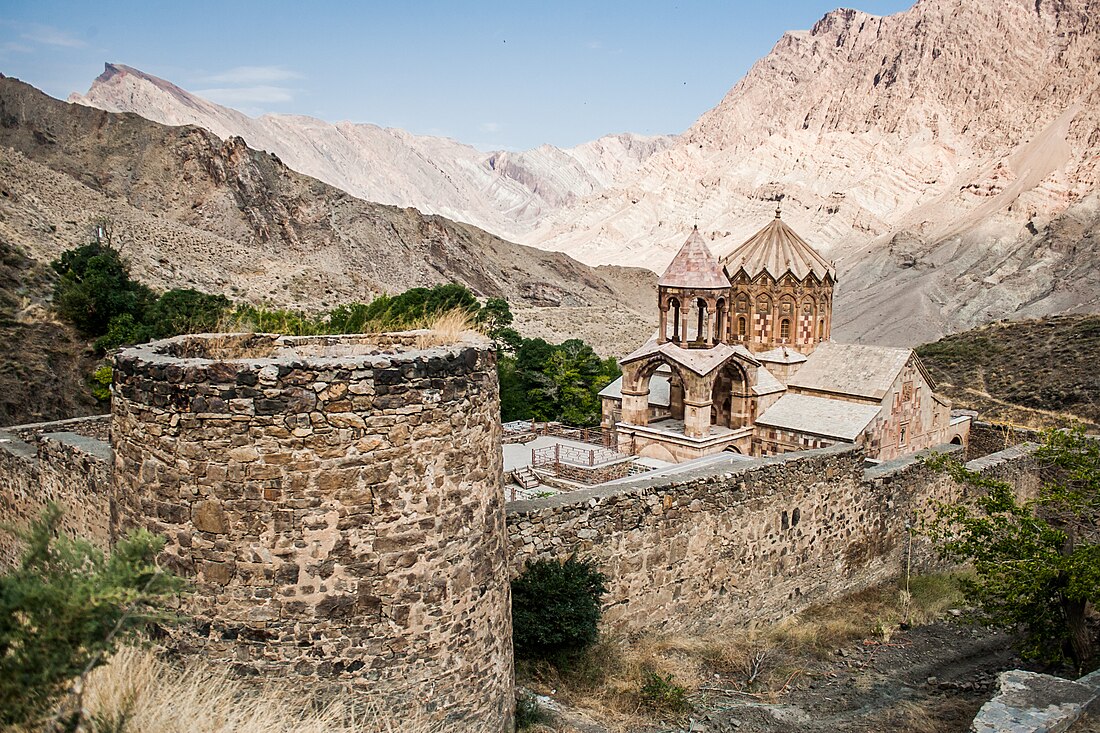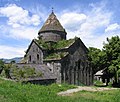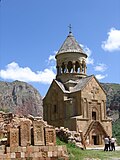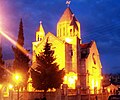Armenian architecture
From Wikipedia, the free encyclopedia
Armenian architecture comprises architectural works with an aesthetic or historical connection to the Armenian people. It is difficult to situate this architectural style within precise geographical or chronological limits,[1] but many of its monuments were created in the regions of historical Armenia, the Armenian Highlands.[2] The greatest achievement of Armenian architecture is generally agreed to be its medieval churches and seventh century churches, though there are different opinions precisely in which respects.
This article contains too many pictures for its overall length. |
The accessibility of this article is in question. The specific issue is: Articles with many images may time out on mobile versions of Wikipedia. Ideally, a page should have no more than 100 images (regardless of how small). See MediaWiki:Limit number of images in a page. Relevant discussion may be found on the talk page. (July 2024) |
From top to bottom: Saint Stepanos Monastery of Julfa (12th century); Church of the Holy Apostles in Ani (c. 9th century); Aghtamar cathedral (c. 8th century); Etchmiadzin cathedral and its Dome (4th century); Monastery of Geghard (13th century); and Kumayri historic district (19th century) | |
| Years active | c. 3rd millennium BC – present |
|---|---|
Common characteristics of Armenian architecture
Summarize
Perspective
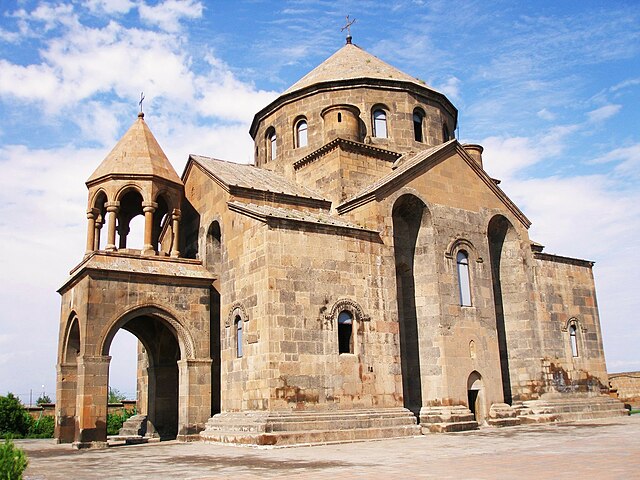

Medieval Armenian architecture, and Armenian churches in particular, have several distinctive features, which some believe to be the first national style of a church building.[3]
Common characteristics include:
- Pointed domes, reminiscent of the volcanic cone of Greater Ararat. The conical or semiconical radially segmented dome or cupola is mounted above vaulted ceilings on a cylindrical drum (usually polygonal on the outside, most often octagonal)[4]
- The vertical emphasis of the whole structure, with the height often exceeding the length of a church[4]
- Reinforcement of the verticality with tall, narrow windows[4]
- Stone vaulted ceilings
- Composed almost entirely of stone, usually volcanic tuff or basalt.
- A composite roof composed of finely cut tuff shingles
- Frescoes and carvings, if present, are usually ornate and include swirling intertwining grapevines and foliage.
- Heavy use of tall structural arches, both for supporting the cupola as part of the drum, the vaulted ceiling, and the vertical walls.
- Roofs intersecting to support the dome, both in basilicas and centrally planned churches.
- Sculptural decoration of external walls, including figures.
Classification of Armenian churches

Within the bounds of the aforementioned common characteristics, individual churches display considerable variation which may reflect time, place, and the creativity of its designer. Toros Toramanian distinguished the following classical styles while studying these variations in the early 20th century:[4]
| Style | Armenian nomenclature | Example |
|---|---|---|
| Basilica | Bazilik (Բազիլիկ) | Ererouk |
| Domed basilica | Gmbetakir bazilik (Գմբեթակիր բազիլիկ) | Tekor Basilica |
| Cruciform | Etchmiadznatip (Էջմիածնատիպ; literally "Etchmiadzin-type") | Etchmiadzin Cathedral |
| Vertical-emphasis rectangular | Oughghagitz karankiun (Ուղղագիծ քառանկյուն) | Saint Gayane Church |
| Radial | Sharavighayin (Շառավիղային) | Saint Hripsime |
| Circular | Zvartnotsatip (Զվարթնոցատիպ; literally "Zvartnots-type") | Zvartnots |
Construction
Summarize
Perspective

Armenian architecture, as it originates in an earthquake-prone region, tends to be built with this hazard in mind. Armenian buildings tend to be rather low-slung and thick-walled in design. Armenia has abundant resources of stone, and relatively few forests, so stone was nearly always used throughout for large buildings. Small buildings and most residential buildings were normally constructed of lighter materials, and hardly any early examples survive, as at the abandoned medieval capital of Ani.

The stone used in buildings is typically quarried all at the same location, to give the structure a uniform color. In cases where different color stone are used, they are often intentionally contrasted in a striped or checkerboard pattern.[3] Powder made out of ground stone of the same type was often applied along the joints of the tuff slabs to give buildings a seamless look.[3] Unlike the Romans or Syrians who were building at the same time, Armenians never used wood or brick when building large structures.
Armenian architecture employs a form of concrete[3] to produce sturdy buildings,. It is a mixture of lime mortar, broken tuff, and rocks around which forms a core against which thin slabs of tuff are arranged in brickwork fashion. As the wet mortar mixture dries it forms a strong concrete-like mass sealed together with the tuff around it and, due to tuff's properties, it becomes harder with time. Initially, almost no core was used in the construction of churches, stone blocks were simply sealed together, but as architects saw how those with mortar cores withstood tremors, the size of the core expanded. Frescos of marble or another stone were often affixed to the side of these buildings, usually at a later date.
History of Armenian architecture
Summarize
Perspective
The gradual development of Armenian architecture.
Pre-Christian Armenia
During the third millennium B.C, prehistoric Armenian architecture was already distinctive. The most common feature was its groundwork, which incorporated many geometrical shapes, ultimately forming a cell shape. An example of such architecture can be found in Kültəpə, near Nakhchivan. These buildings were approximately 6–7 metres wide and about 5 metres high.[5]
Urban architectural traditions, and other forms of art in the years before Christ continued to develop and later were influenced by Greco-Roman art.[6] Urartian architecture is known for its use of intricately cut rocks, used as foundations for mud brick buildings, usually constructed in a compact manner (such as in Erebuni).

Urartian temples had massive stone walls at lower levels and a relatively small interior space, usually square, and rose high; they were generally placed at the highest point of a site. Higher levels were in mud brick, which has not survived, and it is not fully clear how appeared. The late Temple of Garni of the 1st century AD, in a fully Hellenistic style, is the only pagan monument left in any sort of complete state in Armenia, as many others were destroyed or converted to Christian places of worship under Tiridates III of Armenia.[7] Garni includes local elements of sacred numerology and geometry. The temple has a column to inter column ratio of 1/3 (1 is the primary number of the universe and 3 is the holiest of all numbers as it represents the Greco-Roman triad Jupiter, Juno and Minerva). Aside from being aesthetically beautiful, Garni's design can be seen as being a reaffirmation of the universal laws that governed man's destiny. The angles, number of columns, and dimensions were created with a careful eye; Armenian pagans wanted to appease the gods and protect humanity from their wrath. This sacred geometry is evident in the entire temple. To the people who created it, it was the perfect embodiment of their communion with the universe. Note that although sacred geometry was mostly used in religious buildings, secular buildings adopted some aspects of it.[8]
10th century BC – 1st century BC

- Horom Citadel, Bronze Age
- Haykaberd, 1st millennium BC
- Musasir, 825 BC
- The Van Citadel, 9th century BC
- Erebuni Fortress, 782 BC
- Odzaberd, 735–713 BC
- Teishebaini, Between 650 and 600 BC
- Argishtikhinili, 8th and 6th centuries BC
- Kumayri historic district, 5th century BC
- Armavir, 331 Bc (originally 8th century BC)
- Artaxata, 176 BC
- Tigranakert of Artsakh, 2nd–1st century BC
- Mount Nemrut, 1st century BC
Christian Armenia


Christianity's institution as Armenia's official religion in 301 allowed new developments in Armenian architecture, which nevertheless preserved older traditions.[6] In fact it would be almost impossible to find any religion that rose completely on its own without borrowing some traditions from the past. Exploring Armenian churches is critical to our understanding of Medieval Armenia. Beyond that, the Armenian churches describe us the general landscape of the Christian East at a time when eyewitness accounts were exceedingly rare. In their messages of authenticity and legitimacy, the churches shaped and preserved public memory, negotiating among diverse linguistic, religious, political, and ethnic groups.[9]
The first Armenian churches were built on the orders of St. Gregory the Illuminator, and were often built on top of pagan temples, and imitated some aspects of Armenian pre-Christian architecture.[8]
Gallery 4th–7th century
- 4th century Amaras Monastery near Sos
- Dvin, 4th century
- Arshakid Mausoleum, 4th century
- Yererouk Bazelika, 4th–5th century
- Monastery of Saint Translators, 4th–5th century
- Kasagh Basilica, 4th–5th century
- Tsrviz Chapel, 5th century
- Karmir Monastery, 5th century
- Tsiranavor Church, 5th century
- Ani, 5th century
- Smbataberd, 5th century
- Tekor Basilica, end of 5th century
- Tsitsernavank Monastery, Syunik, 4th–6th century
- Saint Paul and Peter Church, 4th–6th century
- Cathedral of Avan, 6th century
- Saint Gevorg church in Irind, 6th century
- Odzun Church, 6th century
- Saint John Church of Sohrol, 5th century or 6th century
- St. George Church, Sverdlov, 6th century
- Bagavan church, 613–619
- Saint Gayane Church, 630
- Sourp Khach Church, c. 635
- Cathedral of Mren, 631–639
- Ruins of Zvartnots Cathedral, 641–652
- Bana cathedral, 653–658
- Gharghavank, 661–685
- Targmanchats monastery, Aygeshat, 6th–7th century
- Ptghnavank, 6th century or 7th century
- Talin Cathedral, 7th century
- Aruchavank, 7th century
- Church of Saint John, Mastara, 7th century
- St. Gregory the Illuminator church, 7th century
- Khtzkonk Monastery, 7th century
- Karmravor Church, 7th century
- Saint George's Church, mid-7th century
- Holy Mother of God Church, Voskepar 7th century
- Saint Christopher Monastery, 7th century
- Artavazik Church, 7th century
- St. Thaddeus Church, Ddmashen, 7th century
- Lmbatavank, 7th century
- Amberd, 7th century
- Aghitu tomb, 7th century
- Ateni Sioni Church, 7th century
8th–14th century
- Kirants Monastery, 8th century
- Chapel of Dzordzor 9th century
- Saint Stepanos Monastery, 9th century
- Kotavank, 9th century
- Dashtadem Fortress, 9th century
- Holy Saviour's monastery of Yerazgavors, end of 9th century
- Tatev Monastery, 895–906
- Vanevan Monastery, 903
- Vahanavank, 911
- Cathedral of Kars 930–967
- Gndevank, 931–936
- Sanahin Monastery, 957–966
- Haghpat Monastery, 976–991
- Cathedral of Ani, 989–1001
- Kakavaberd,9th–10th century
- Bjni Fortress, 9th–10th century
- The church of St Gregory of the Abughamrents, Ani, 10th century
- Noratus cemetery, 10th century
- Tmkaberd, 10th century
- Horomos, 10th century
- Berdavan Fortress, 10th century
- Surp Hovhannes Church, Byurakan, 10th century
- Narekavank, 10th century
- Tsaghats Kar Monastery, 10th century
- Karmravank, 10th century
- Arakelots Monastery, Kirants, 10th century
- Surb Nshan Monastery, 10th century.
- Vorotnavank, 1000.
- King Gagik's church of St Gregory, Ani, 1001–1020
- Vahramashen Church, 1026
- Kecharis Monastery, 1033
- Bgheno-Noravank, 1062
- Meghri Fortress, 1083
- Eghegnamor Monastery,10th century–11th century
- Neghuts Monastery,10th century or 11th century
- Arakelots Monastery 11th century
- Goshavank, 1191–1196
- Surp Hovhannes Church, 7th–12th century
- Hnevank, 7th–12th century
- Mashtots Hayrapet Church of Garni, 12th century
- Church of Kish, 12th century
- Jukhtak Vank, 12th century
- Castle of Kars, 1153
- Kobayr monastery, 1171
- Lori Fortress, 1177
- Tejharuyk Monastery, 1196–1199
- Hayravank Monastery,9th–12th century
- Paperon, 12th century
- Harichavank Monastery, 1201
- Hogevank Monastery, 1205
- Geghard, 1215
- St Gregory of Tigran Honents, Ani, 1215
- Hovhannavank, 1216
- Saghmosavank, 1215–1221
- Gtichavank, 1241–1246
- Matosavank,1247
- Cathedral of Arapgir, 1249
- Saint George's Church, 1251 or earlier
- Yeghishe Arakyal Monastery, 5th–13th century
- Saint Sarkis Monastery of Ushi, 7th–13th
- Tanahat Monastery, 8th–13th century
- Makenyats Vank,9th–13th century
- Horomayr Monastery, 10th–13th century
- Makravank Monastery, 10th–13th
- Haghartsin Monastery, 10th–13th
- Makaravank, 10th–13th century
- Bagnayr Monastery, 10th-13tg century
- Yeghipatrush Church, 10th–13th century
- Khuchap Monastery, 12th–13th century
- Kusanats Anapat, 12th–13th century
- Samsonavank Monastery, 12th–13th century
- Chapel in the Monastery of the Hripsimian Virgins, Ani, 13th century
- Aghjots Vank, 13th century
- Levonkla, 13th century
- Caravanserai of Zor, 13th century
- Tegher Monastery, 13th century
- Spitakavor Church of Ashtarak, 13th century
- Akhtala Monastery, 13th century
- Tanahat Monastery, 13th century
- Saint Bartholomew Monastery, 13th century
- Church of Saint Elia, Kizkale, 13th century
- Lim Island, 1305
- Saint Thaddeus Monastery, 1319–1329
- Areni Church, 1321
- Spitakavor Monastery, 1321–1330
- Orbelian's Caravanserai, 1332
- Noravank, 1339
- Surp Khach Monastery, 1358
- Ganchvor monastery, 1364
- Armenian Cathedral of Lviv, 1363–1370
- Nor Varagavank, 13th–14th century
- Mayravank, 7th–14th centuries
15th–18th century
- Ktuts monastery, 15th century
- Armenian monastery of Suceava, 15th century
- Norashen Church, 1507
- Chapel of Chupan, 1518
- Hoşap Castle, 1649
- Vank Cathedral, 1655–1664
- Khor Virap, 1661
- Saint Gevork Monastery of Mughni, 1661–1669
- Surp Astvatsatsin Church, 1338–1693
- Shoghakat Church, 1694
- Aparank Monastery,10th–17th century
- Bridge in Shvanidzor, 17th century
- Holy Resurrection Church, 1781
- Church of the Ascension, 1790
- Holy Cross Church, 1786–1792
- Church of St. Gevorg (Sighnaghi), 1793
- Church of the Holy Mother of God, Darashamb, 18th century
- St. Sarkis Church (Ashtarak, Aragatsotn, Armenia), 18th century
- Surp Gevork Church, Noragavit, 18th century
- Togh's Melikian Palace, 18th century
19th–20th century
- Surb Karapet Monastery, 4th–19th century
- Tatevi Anapat, 18th–19th century.
- Saint Sarkis Cathedral, 1842
- Armenian Church, Baku, 1863–1869
- Church of the Holy All-Savior, 1860–1871
- Holy Saviour's Church, 1858–1872
- Gevorgian Seminary, 1874
- Saint Mesrop Mashtots Church, 443–1879
- Cathedral of the Holy Mother of God, 1873–1884
- Ghazanchetsots Cathedral, 1868–1887
- St. Astvatsatsin Church, 1902–1905
- Church of Surp Hakob, 1967–1969
- St. Sarkis Church, 1998
Periods in Armenian architecture
Summarize
Perspective
Classical and Medieval Armenian architecture is divided into four separate periods.[3]
The formative period

The first Armenian churches were built between the 4th and 7th century, beginning when Armenia converted to Christianity, and ending with the Arab invasion of Armenia. The early churches were mostly simple basilicas, but some with side apses. By the 5th century the typical cupola cone in the center had become widely used. By the 7th century, centrally-planned churches had been built and a more complicated niched buttress and radiating Hrip'simé style had formed. By the time of the Arab invasion, most of what we now know as classical Armenian architecture had formed.[10]
Bagratid revival

From the 9th to 11th century, Armenian architecture underwent a revival under the patronage of the Bagratid dynasty with a great deal of building done in the area of Lake Van, this included both traditional styles and new innovations. Ornately carved Armenian khachkars were developed during this time.[7] Many new cities and churches were built during this time, including a new capital at Lake Van and a new Cathedral on Akdamar Island to match. The Cathedral of Ani was also completed during this dynasty. It was during this time that the first major monasteries, such as Haghpat and Haritchavank were built. This period was ended by the Seljuk invasion.
Monasteries flourish


From the 12th to 14th century under the Zakarid dynasty saw an explosion in the number of monasteries built, including Saghmosavank Monastery, the Akhtala Monastery, Kaymaklı Monastery, Kecharis Monastery and Makaravank Monastery. Monasteries were institutes of learning, and much of medieval Armenian literature was written in this time period. The invasion of Timurlane and the destruction of Cilician Armenia ended architectural progression from another 250 .
Seventeenth century
The last great period in classic Armenian construction was under the Iranian Safavid Shahs, under which a number of new churches were built, usually at existing holy sites such as Etchmiadzin as well as in diaspora communities like New Julfa.[3]
Nineteenth century

Armenian architecture experienced a huge stage of development during the 19th century, when the Russians entered Eastern Armenia. A number of architectural masterpieces were built in the Kumayri historic district of Alexandropol and Yerevan, as well in Kars, which is now a part of the Republic of Turkey.
The Armenian buildings of that time were mainly made of black tuff, therefore those buildings were mainly of black color.
Gallery of Armenian architecture of the 19th century – 20th century
- Yerevan
- Yerevan State University old building
Modern times
One of the most prolific architects of Armenian architectural monuments in the 20th century was Baghdasar Arzoumanian. Based in Yerevan, Armenia, he was the author of a great number of civil and church buildings along with other designs. The legendary architects of the 20th century were Alexander Tamanyan, Rafael Israyelyan, G. Kochar, E. Tigranyan, S. Safaryan, etc. Today the masters of Armenian architecture are S.Gurzadyan, S. Kalashyan, L. Khristaforyan, R. Asratyan etc.
Devastation of Armenian architecture
Summarize
Perspective

As a result of Anti-Armenianism, relics of Armenia's past such as churches, cemeteries and khachkars in neighboring countries have been subject to devastation. In certain cases such as in Turkey or Azerbaijan, this had been as a result of national campaigns to eradicate traces of the Armenian people to thwart any potential claims by the Armenian state.
The largest collection in the world was formerly to be found at the ruins of Old Jugha in Nakhichevan (today's Azerbaijan). Reports (see RFE/RL) and photographs from observers in Iranian territory emerged at the end of 2005 showing Azeri soldiers making deliberate attempts to destroy the gravestones. More recent photographs have revealed that the entire graveyard has been obliterated and a military training ground has been constructed on the site.[11]
Due to the endless development and neglect, the historical architecture of Yerevan is often desecrated or in some cases demolished.[12] One of the most noticeable cases was the creation of Northern Avenue in Yerevan as per original plans of Alexander Tamanian, which destroyed the rich architectural heritage located in the area.[13] There are also plans going on to destroy the historical district of Noragyugh to build a business center called "New Yerevan".[14]
Vernacular architecture of Armenia
Summarize
Perspective
Armenia has a rich tradition of vernacular architecture, which varies by region. Out of them the most noticeable surviving examples are the following:
- In Syunik region Armenians used to live in carved out cave dwellings with decorated entrances. Between 12 and 25 people lived in each cave, depending on the economic status of the family, with the complex network of ropes, ladders and narrow pathways connecting each dwelling. [15] The examples of this style can be found in the old parts of Khot, Khndzoresk, Shinuhayr and Halidzor villages, as well as in Meghri and Goris cities.
- In Dilijan the local vernacular architecture is a product synthesis between the Armenian architecture of Tbilisi and Baku and the Molokan architecture due to the high Molokan and Tbilisi Armenian population living in the city. The architecture of Dilijan consisted of one- or rarely two-story housing, made of uncut gray basalt and sandy limestone. The windows and doorways of the houses were covered with arches traditional to Armenia, and high gabled roofs were covered with roofing tiles due to the abundance of precipitation.[16]
- The vernacular architecture of Yerevan is primarily represented by the historical Kond district, as well as the integrated villages of Old Nork, Kanaker and Noragyugh. [17] Demirbulagh and Dzoragyugh districts, which also represented the vernaculars of Yerevan, were mostly demolished, as can be seen on the architectural plan of Tamanian. [18] The vernaculars of Yerevan are characterised by simple wooden balconies, narrow streets and terraces, which are often situated on top of the other houses due to the mountainous terrain.[19]
- The vernaculars of Lori region in Armenia are similar to the vernaculars of Dilijan, though they are more sparse due to the major reconstruction of the capital of the region, Vanadzor, by Soviets, which almost entirely destroyed its vernacular heritage. Traditional housing in Lori is almost exclusively one-story and has white plastered walls, representing the unique combination of cultures. [20] Nowadays, probably the best example of the architecture of that region is the house-museum of Stepan Shaumian in Stepanavan.
- Traditional house in Dilijan.
- House of Shaumian, Stepanavan, Lori.
Armenian architecture in the diaspora
The tumultuous past of Armenia over the last millennium has resulted in the formation of an extensive Armenian diaspora in various corners of the globe. Armenian communities seeking to keep the traditions of their homeland, influenced the architectural vernacular of Armenian Quarters in cities such as Zamość and Lviv. This influence is most evident in the sacred architecture of churches built by the Armenian community, where designs based on historic landmarks such as the cathedrals of Ani, Zvartnots and Etchmiadzin have been used as inspirational templates to construct these structures in their new surroundings. This tradition still continues into the present day as Armenian immigration has shifted away from the traditional areas of outmigration in Europe and the Middle East into the Americas and Australia.
Khachkars have also become additional signifiers of Armenian identity and have been erected in recent year in cities such as Wrocław, Kraków, Elbląg in Poland, Novi Sad in Serbia, Beirut in Lebanon as well as in Dearborn, Michigan.
- Church of the Nativity, 325–565.
- Cathedral of Saint James, Jerusalem, 12th century.
20th century secular buildings in Armenia
- 20th century
- National Assembly (1918).
- Yerevan State University in 1968, (1919).
- Yerevan State Medical University in 1960s, (1920).
- Yerevan opera house by A. Tamanyan in 1951, (1926–1939).
- Unevermag of Yerevan (1935).
- Moscow Cinema (1936).
- The Victory Bridge, Yerevan on Hrazdan River (1945).
- Pak Suka in 1968, (1952).
- Matenadaran (1920–1959).
- Tsitsernakaberd (1967).
- Erebuni Museum (1968).
- Yerevan Youth Palace (1970).
- Republic Square, Yerevan by A.Tamanyan in 1953, (1926–1977).
- Komitas Chamber Music House (1977).
- Yerevan Cascade (1971–1980).
- Karen Demirchyan Complex (1983).
21st century buildings in Armenia
- Saint Gregory the Illuminator Cathedral, 1997–2001
- Church of St. Nerses the Great, 2004 .
- Saint Anna Church, 2011–2014
- COAF SMART center in the village of Debet, Lori province.
- Holy Mother of God Cathedral, 2006–2019
UNESCO designated World Heritage Sites

Armenian cross-stones art and Symbolism and craftsmanship of Khachkars, listed to UNESCO intangible world heritage site. The following is a list of World Heritage Sites designed or constructed by Iranians, or designed and constructed in the style of Armenian architecture:
- Inside Armenia
- Outside Armenia
- Church of the Holy All-Savior of Derbent in Russia
- Ani in Turkey
- Ani Cathedral in Turkey
- The church of the Holy Redeemer in Turkey
- The church of St Gregory of the Abughamrents in Turkey
- St Gregory of Tigran Honents in Turkey
- Monastery of the Hripsimian Virgins in Turkey
- King Gagik's church of St Gregory in Turkey
- St. Thaddeus Monastery in Iran
- Saint Stepanos Monastery in Iran
- Chapel of Dzordzor in Iran
- Chapel of Chupan in Iran
- Church of the Holy Mother of God, Darashamb in Iran
Gallery
Summarize
Perspective
Examples of Armenian religious architecture
Armenia
- The Holy Trinity Church (2003) modeled after Zvartnots Cathedral, in the Malatia-Sebastia district of Yerevan
- The Saint Gregory of Narek Cathedral (2005) in Vanadzor, Armenia
Azerbaijan
- 13th century Gandzasar monastery, near Vank village
- 12th-century Holy Mother of God Church, Hunarli, Azerbaijan
Iran
Turkey
- Aghperig Monastery, 300
Elsewhere in Western Asia
- Saint Gregory the Illuminator – Saint Elie (Eghishe) Armenian Catholic Cathedral (1909) in downtown Beirut, Lebanon
- The Holy Mother of God Cathedral (1940) at the Catholicossate of the Great House of Cilicia in Antelias, Lebanon
- Holy Cross Church (Sourp Nshan) in downtown Beirut, Lebanon, adjacent to the Grand Serail
- Holy Mother of God Church (Sourp Asdvadzadzin) at the Armenian Seminary in Bikfaya, Lebanon
- The belfry of the Forty Martyrs Armenian Cathedral of Aleppo erected in 1912
- Armenian genocide Memorial Church in Deir ez-Zor, Syria
- St. Gregory The Illuminator Armenian Apostolic Church (1928) in Cairo, Egypt
- Interior of St. Gregory The Illuminator Church of Cairo
- Saint John the Baptist Armenian church on Jordan River, Al-Maghtas, Jordan
Georgia
North America
- Holy Trinity Armenian Apostolic Church (1914) in Fresno, California
- Saint Paul Armenian Church (1979) in Fresno, California
- The Saint Gregory the Illuminator Armenian Catholic Church (2001) in Glendale, California
- Saint Stepanos Armenian Church (1986) in Elberon, New Jersey
- St Gregory Armenian Church in Springfield, Massachusetts,USA
- St. Mary Armenian Apostolic Church, Toronto (1983) in Toronto, Ontario, Canada
Russia
- Holy Transfiguration Cathedral, Moscow
Singapore
- Armenian Church, Singapore, (1836).
See also
- Armenian art
- Armenian church architecture
- List of castles in Armenia
- List of monasteries in Armenia
- List of cathedrals in Armenia
- List of bridges in Armenia
- Armenian Khachkars
- Armenian Palaces
- Gavit
- Vishapakar
- Stone sculptures of horses and sheep in the Caucasian States
- Armenian Union of Architects
- Children of Armenia Fund
- Research on Armenian Architecture
- Tumo Center for Creative Technologies
- Architecture of Urartu
References
Bibliography
External links
Wikiwand - on
Seamless Wikipedia browsing. On steroids.
